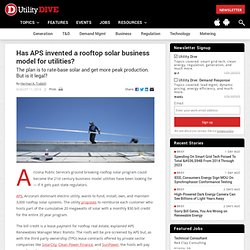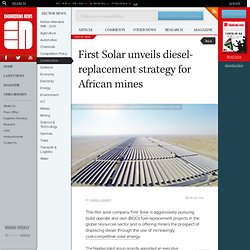

Tucson Electric Power proposes new utility-owned rooftop solar program. How should utilities value solar? Solar is a revenue opportunity utilities can no longer ignore.

Has APS invented a rooftop solar business model for utilities? Arizona Public Service’s ground breaking rooftop solar program could become the 21st century business model utilities have been looking for — if it gets past state regulators.

APS, Arizona’s dominant electric utility, wants to fund, install, own, and maintain 3,000 rooftop solar systems. The utility proposes to reimburse each customer who hosts part of the cumulative 20 megawatts of solar with a monthly $30 bill credit for the entire 20 year program. The bill credit is a lease payment for rooftop real estate, explained APS Renewables Manager Marc Romito. The roofs will be pre-screened by APS but, as with the third party ownership (TPO) lease contracts offered by private sector companies like SolarCity, Clean Power Finance, and SunPower, the hosts will pay no upfront fees and have no ownership responsibilities.
APS determined $30 to be the value of the roof space through a study of other U.S. utility programs and consultations with local solar installers.
Solar Leasing. Solar group to use balance sheet to unlock diesel-replacement opportunities at African mines. By: Terence Creamer Thin-film solar company First Solar is aggressively pursuing build operate and own (BOO) fuel-replacement projects in the global resources sector and is offering miners the prospect of displacing diesel through the use of increasingly cost-competitive solar energy.

The Nasdaq-listed group recently appointed an executive with the specific mandate of promoting these hybrid solutions and also confirmed that its $1-billion-strong balance sheet could be leveraged in support of the strategy. Fuel replacement solutions director John Eccles, who is based in Australia and who will be marketing the concept at the Mining Indaba, in Cape Town, reported that advanced discussions were already under way with multinational mining groups, with particularly strong interest being shown in Australia and Africa, including mining-heavy, but power-light South Africa. Vodacom, Mobisol partner in lighting Tanzania villages. The Open PV Project.
How Fast Are The Costs Of Solar Really Coming Down? The case for solar energy as a near term alternative to fossil energy hangs largely upon the view that the costs of solar energy have come down rapidly in recent years and will continue to do so in the coming years.

But a close examination of where and why solar costs appear to be declining casts doubt on those claims. Solar module prices have dropped substantially in recent years. But much of the decline in recent years has been due to Chinese overproduction and dumping. Installed costs of solar systems have come down dramatically in Germany. But a significant portion of the cost declines experienced in Germany that the rest of the world hopes to emulate are from non-module “soft” costs. While low module costs may remain in place for some time due to the current glut of panels on the market, sustaining the pace of cost reductions in module prices that have been observed in recent years appears unlikely while the Chinese solar industry consolidates.
Solar Power. Next-generation photovoltaics Researchers are developing next-generation materials as well as new methods for producing PVs to increase conversion efficiency and lower production costs.

Many of these technologies, for example organic solar cells, are not dependent on rare earth minerals; thin film PV modules, on the other hand, are commonly made from rare earths such as tellurium, gallium, and indium.[9] Concentrating PV, not be confused with Concentrating Solar Power (CSP)–using lenses or mirrors to concentrate sunlight onto special PV materials—may prove to be a lower-cost solar power option.
Nano-scale materials, such as carbon nanotubes, could also yield breakthrough applications for PV materials.[10] Others believe they can achieve low-cost solar electricity via the use of organic materials, bioengineering, and streamlined manufacturing processes.[11] Www.eia.gov/forecasts/aeo/er/pdf/tbla16.pdf. Solar Energy Industries Association. How Net Metering Works" You've seen the dire warnings on the news about shrinking energy resources and increasing environmental problems.

In your effort to become a better global citizen, you've installed solar panels on your roof. You're also being careful to turn off your lights and appliances when you leave for work each morning. While you're away, your house is generating energy but you're not using it. Meanwhile at night, when you have the lights and TV blaring, your solar system is sitting idle. You could buy an expensive battery to store the extra energy you generate during the day, but there's another option that allows you to send your extra power to the grid in exchange for banked energy credit that you can use when you need it. When your home is equipped with a renewable energy source (such as wind or solar power), it sends the excess energy that's generated back into the grid to power other homes.
Net metering can be measured over the month or year. Solar Power Purchase Agreement Graphic. Four Ways The Solar Boom Has Rattled Utilities. Welcome To The Residential Solar Revolution.